Financial Management Exam: Costing, Variances, and Budgeting
VerifiedAdded on 2022/12/29
|11
|2512
|94
Homework Assignment
AI Summary
This document presents a comprehensive solution to a Financial Management online exam. The solution begins by calculating the cost and profit per unit using both labor hour-based and Activity-Based Costing (ABC) approaches, followed by a critical evaluation of the two methods. The analysis includes detailed calculations and comparisons of the results. The solution then delves into variance analysis, calculating material usage, mix, and yield variances, and discusses the limitations of the current variance reporting system. The final section critically examines Zero-Based Budgeting (ZBB) and Incremental Budgeting (IB), evaluating their roles in planning, coordination, and control, and explaining why neither provides a perfect solution. The document provides detailed calculations and analysis for each question, offering a thorough understanding of the concepts covered in the exam.

Financial
Management
(online exam)
Management
(online exam)
Paraphrase This Document
Need a fresh take? Get an instant paraphrase of this document with our AI Paraphraser
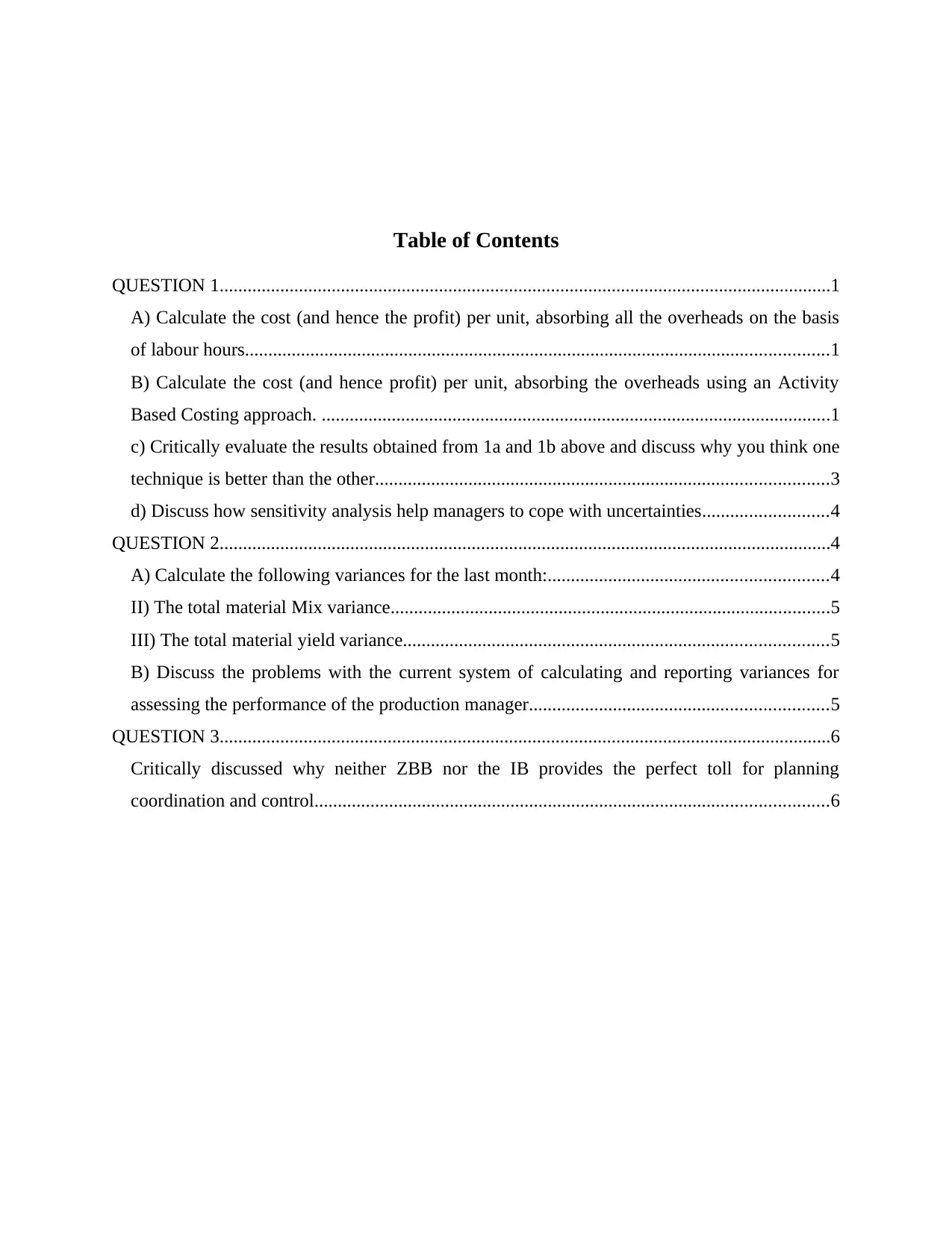
Table of Contents
QUESTION 1...................................................................................................................................1
A) Calculate the cost (and hence the profit) per unit, absorbing all the overheads on the basis
of labour hours.............................................................................................................................1
B) Calculate the cost (and hence profit) per unit, absorbing the overheads using an Activity
Based Costing approach. .............................................................................................................1
c) Critically evaluate the results obtained from 1a and 1b above and discuss why you think one
technique is better than the other.................................................................................................3
d) Discuss how sensitivity analysis help managers to cope with uncertainties...........................4
QUESTION 2...................................................................................................................................4
A) Calculate the following variances for the last month:............................................................4
II) The total material Mix variance..............................................................................................5
III) The total material yield variance...........................................................................................5
B) Discuss the problems with the current system of calculating and reporting variances for
assessing the performance of the production manager................................................................5
QUESTION 3...................................................................................................................................6
Critically discussed why neither ZBB nor the IB provides the perfect toll for planning
coordination and control..............................................................................................................6
QUESTION 1...................................................................................................................................1
A) Calculate the cost (and hence the profit) per unit, absorbing all the overheads on the basis
of labour hours.............................................................................................................................1
B) Calculate the cost (and hence profit) per unit, absorbing the overheads using an Activity
Based Costing approach. .............................................................................................................1
c) Critically evaluate the results obtained from 1a and 1b above and discuss why you think one
technique is better than the other.................................................................................................3
d) Discuss how sensitivity analysis help managers to cope with uncertainties...........................4
QUESTION 2...................................................................................................................................4
A) Calculate the following variances for the last month:............................................................4
II) The total material Mix variance..............................................................................................5
III) The total material yield variance...........................................................................................5
B) Discuss the problems with the current system of calculating and reporting variances for
assessing the performance of the production manager................................................................5
QUESTION 3...................................................................................................................................6
Critically discussed why neither ZBB nor the IB provides the perfect toll for planning
coordination and control..............................................................................................................6
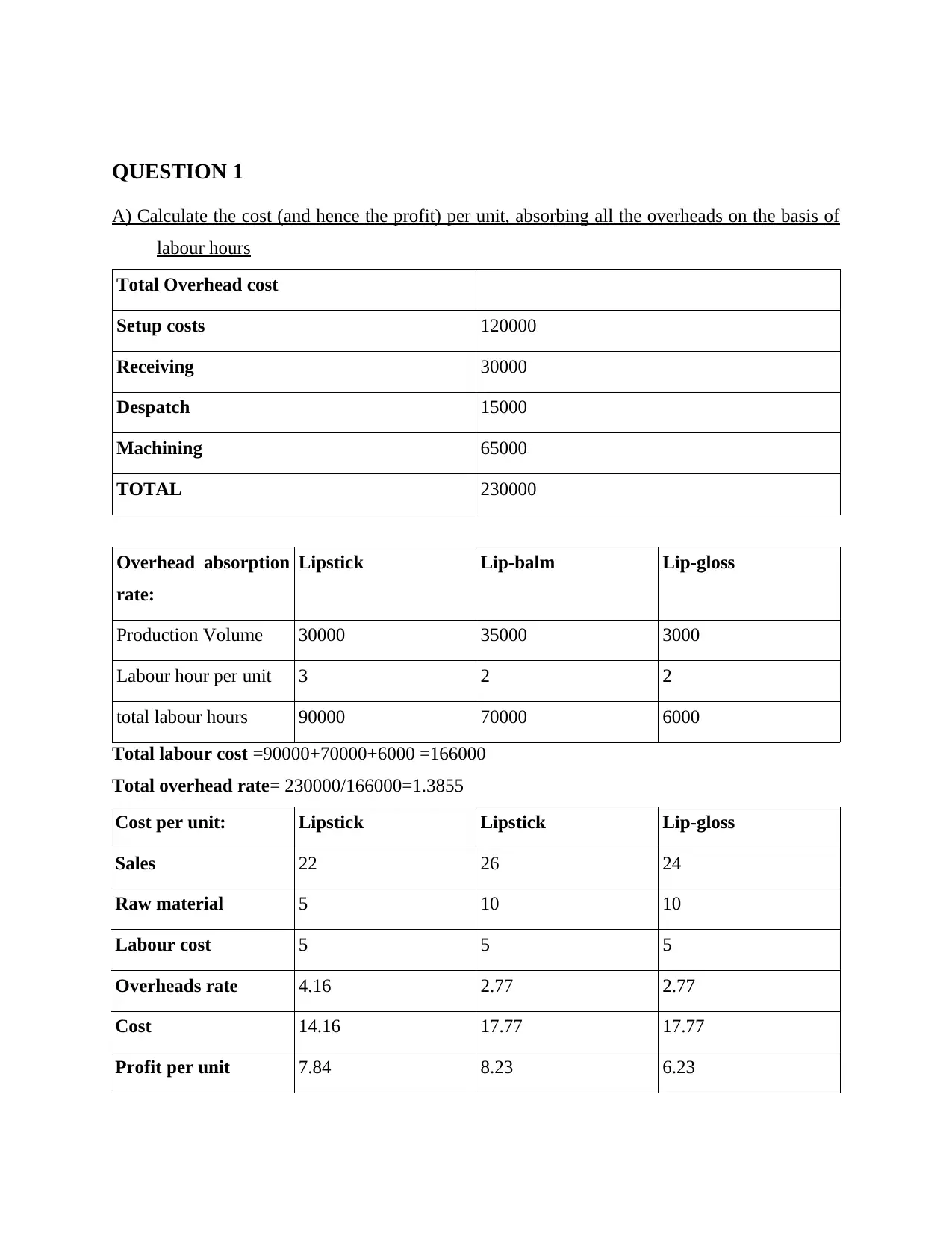
QUESTION 1
A) Calculate the cost (and hence the profit) per unit, absorbing all the overheads on the basis of
labour hours
Total Overhead cost
Setup costs 120000
Receiving 30000
Despatch 15000
Machining 65000
TOTAL 230000
Overhead absorption
rate:
Lipstick Lip-balm Lip-gloss
Production Volume 30000 35000 3000
Labour hour per unit 3 2 2
total labour hours 90000 70000 6000
Total labour cost =90000+70000+6000 =166000
Total overhead rate= 230000/166000=1.3855
Cost per unit: Lipstick Lipstick Lip-gloss
Sales 22 26 24
Raw material 5 10 10
Labour cost 5 5 5
Overheads rate 4.16 2.77 2.77
Cost 14.16 17.77 17.77
Profit per unit 7.84 8.23 6.23
A) Calculate the cost (and hence the profit) per unit, absorbing all the overheads on the basis of
labour hours
Total Overhead cost
Setup costs 120000
Receiving 30000
Despatch 15000
Machining 65000
TOTAL 230000
Overhead absorption
rate:
Lipstick Lip-balm Lip-gloss
Production Volume 30000 35000 3000
Labour hour per unit 3 2 2
total labour hours 90000 70000 6000
Total labour cost =90000+70000+6000 =166000
Total overhead rate= 230000/166000=1.3855
Cost per unit: Lipstick Lipstick Lip-gloss
Sales 22 26 24
Raw material 5 10 10
Labour cost 5 5 5
Overheads rate 4.16 2.77 2.77
Cost 14.16 17.77 17.77
Profit per unit 7.84 8.23 6.23
⊘ This is a preview!⊘
Do you want full access?
Subscribe today to unlock all pages.

Trusted by 1+ million students worldwide

Units 30000 35000 3000
Profit 235301.20 288012.05 18686.75
B) Calculate the cost (and hence profit) per unit, absorbing the overheads using an Activity
Based Costing approach.
Cost Driver
Setup costs 120000 25 setups
Receiving 30000 22 deliveries
Despatch 15000 50 despatched
Machining 65000 12 machining
Cost driver data:
Machine hours per
unit
4 4 4
Number of setups 10 14 1
Number of deliveries
received
10 10 2
Number of orders
despatched
20 20 10
Cost per setup= 120000/25=4800
Cost per receiving activity= 30000/22=1363.63
Cost per despatch=15000/50=300
Cost per machining activity =65000/12=5416.66
Allocation of
overheads to
Lipstick Lip-balm Lip-gloss
Profit 235301.20 288012.05 18686.75
B) Calculate the cost (and hence profit) per unit, absorbing the overheads using an Activity
Based Costing approach.
Cost Driver
Setup costs 120000 25 setups
Receiving 30000 22 deliveries
Despatch 15000 50 despatched
Machining 65000 12 machining
Cost driver data:
Machine hours per
unit
4 4 4
Number of setups 10 14 1
Number of deliveries
received
10 10 2
Number of orders
despatched
20 20 10
Cost per setup= 120000/25=4800
Cost per receiving activity= 30000/22=1363.63
Cost per despatch=15000/50=300
Cost per machining activity =65000/12=5416.66
Allocation of
overheads to
Lipstick Lip-balm Lip-gloss
Paraphrase This Document
Need a fresh take? Get an instant paraphrase of this document with our AI Paraphraser
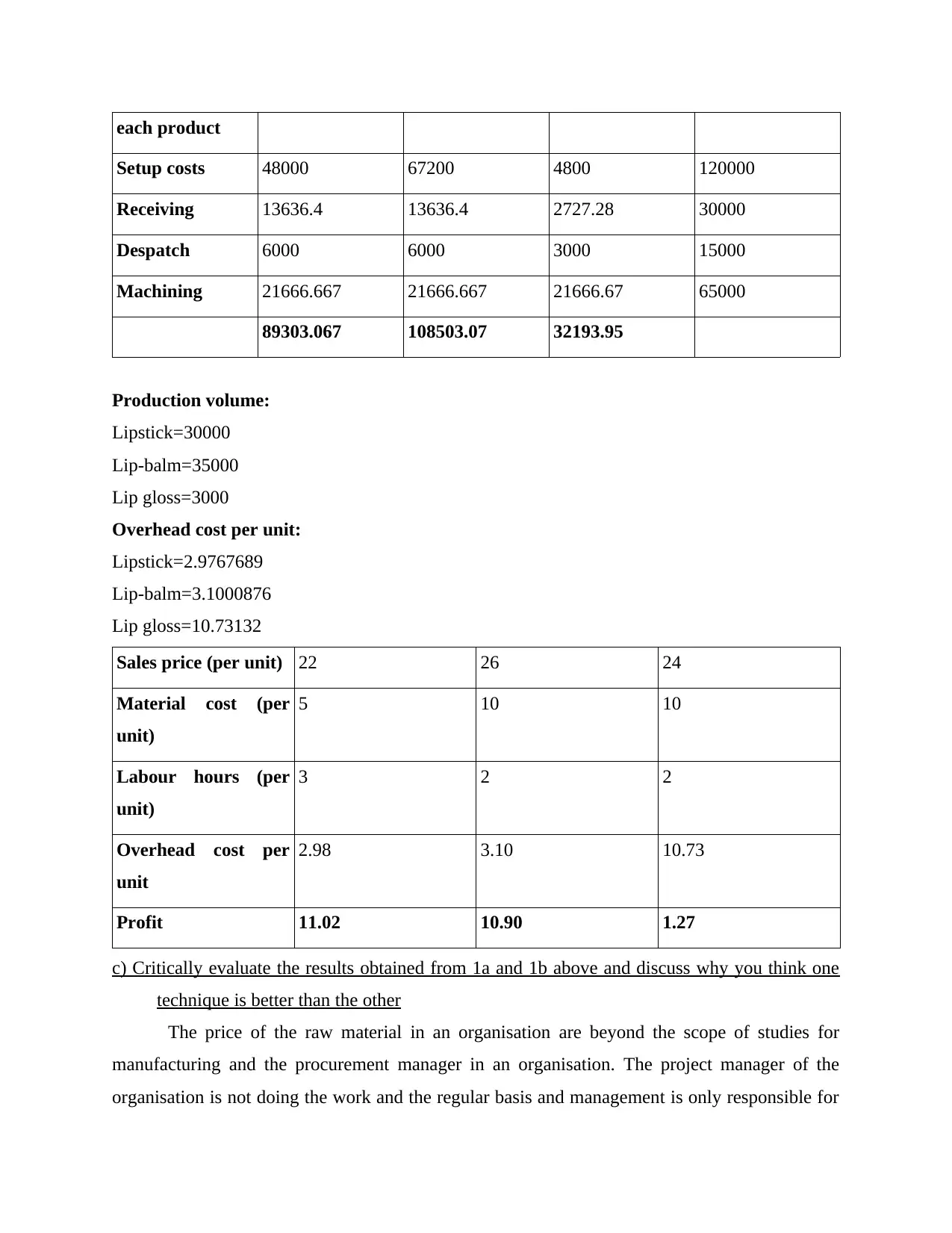
each product
Setup costs 48000 67200 4800 120000
Receiving 13636.4 13636.4 2727.28 30000
Despatch 6000 6000 3000 15000
Machining 21666.667 21666.667 21666.67 65000
89303.067 108503.07 32193.95
Production volume:
Lipstick=30000
Lip-balm=35000
Lip gloss=3000
Overhead cost per unit:
Lipstick=2.9767689
Lip-balm=3.1000876
Lip gloss=10.73132
Sales price (per unit) 22 26 24
Material cost (per
unit)
5 10 10
Labour hours (per
unit)
3 2 2
Overhead cost per
unit
2.98 3.10 10.73
Profit 11.02 10.90 1.27
c) Critically evaluate the results obtained from 1a and 1b above and discuss why you think one
technique is better than the other
The price of the raw material in an organisation are beyond the scope of studies for
manufacturing and the procurement manager in an organisation. The project manager of the
organisation is not doing the work and the regular basis and management is only responsible for
Setup costs 48000 67200 4800 120000
Receiving 13636.4 13636.4 2727.28 30000
Despatch 6000 6000 3000 15000
Machining 21666.667 21666.667 21666.67 65000
89303.067 108503.07 32193.95
Production volume:
Lipstick=30000
Lip-balm=35000
Lip gloss=3000
Overhead cost per unit:
Lipstick=2.9767689
Lip-balm=3.1000876
Lip gloss=10.73132
Sales price (per unit) 22 26 24
Material cost (per
unit)
5 10 10
Labour hours (per
unit)
3 2 2
Overhead cost per
unit
2.98 3.10 10.73
Profit 11.02 10.90 1.27
c) Critically evaluate the results obtained from 1a and 1b above and discuss why you think one
technique is better than the other
The price of the raw material in an organisation are beyond the scope of studies for
manufacturing and the procurement manager in an organisation. The project manager of the
organisation is not doing the work and the regular basis and management is only responsible for
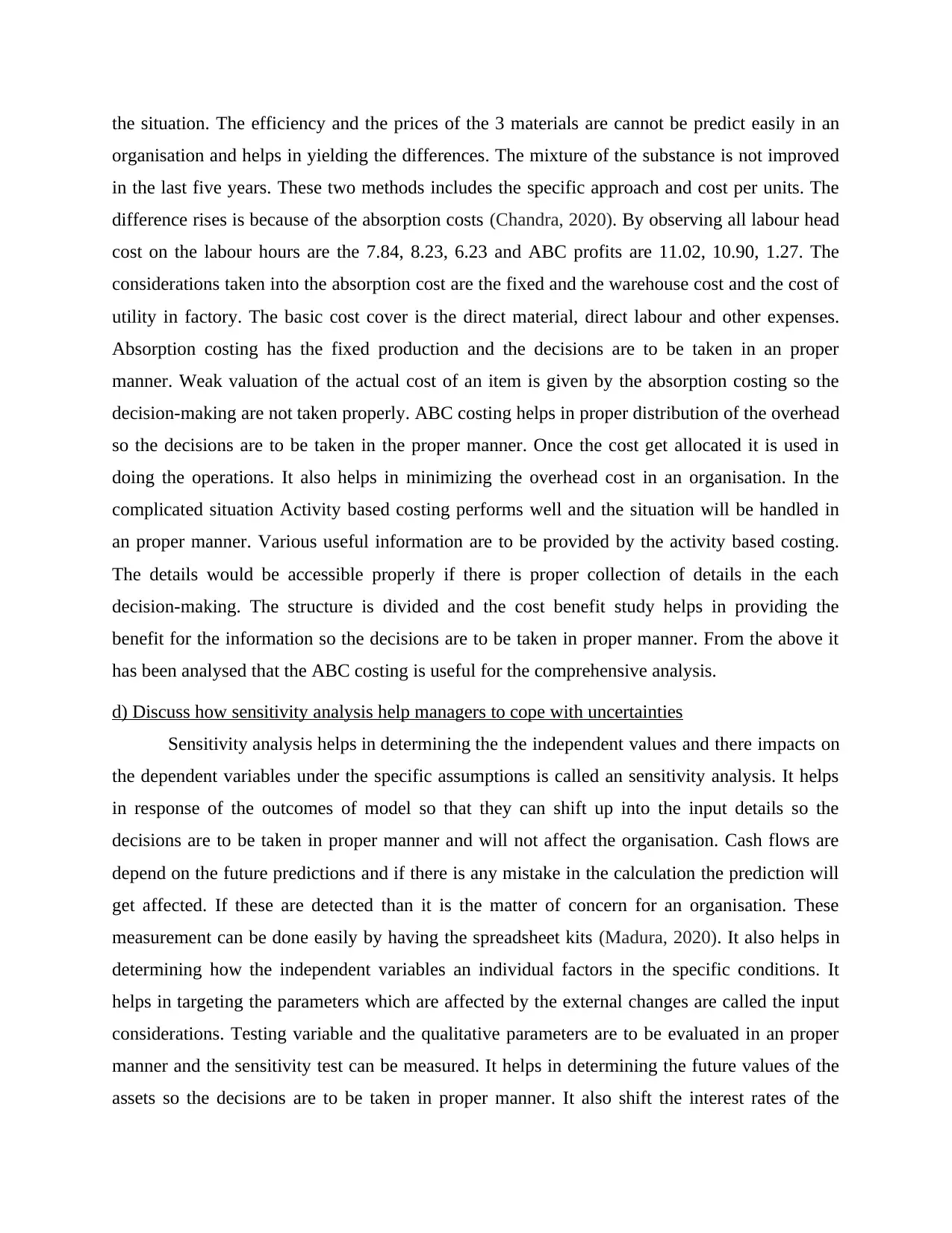
the situation. The efficiency and the prices of the 3 materials are cannot be predict easily in an
organisation and helps in yielding the differences. The mixture of the substance is not improved
in the last five years. These two methods includes the specific approach and cost per units. The
difference rises is because of the absorption costs (Chandra, 2020). By observing all labour head
cost on the labour hours are the 7.84, 8.23, 6.23 and ABC profits are 11.02, 10.90, 1.27. The
considerations taken into the absorption cost are the fixed and the warehouse cost and the cost of
utility in factory. The basic cost cover is the direct material, direct labour and other expenses.
Absorption costing has the fixed production and the decisions are to be taken in an proper
manner. Weak valuation of the actual cost of an item is given by the absorption costing so the
decision-making are not taken properly. ABC costing helps in proper distribution of the overhead
so the decisions are to be taken in the proper manner. Once the cost get allocated it is used in
doing the operations. It also helps in minimizing the overhead cost in an organisation. In the
complicated situation Activity based costing performs well and the situation will be handled in
an proper manner. Various useful information are to be provided by the activity based costing.
The details would be accessible properly if there is proper collection of details in the each
decision-making. The structure is divided and the cost benefit study helps in providing the
benefit for the information so the decisions are to be taken in proper manner. From the above it
has been analysed that the ABC costing is useful for the comprehensive analysis.
d) Discuss how sensitivity analysis help managers to cope with uncertainties
Sensitivity analysis helps in determining the the independent values and there impacts on
the dependent variables under the specific assumptions is called an sensitivity analysis. It helps
in response of the outcomes of model so that they can shift up into the input details so the
decisions are to be taken in proper manner and will not affect the organisation. Cash flows are
depend on the future predictions and if there is any mistake in the calculation the prediction will
get affected. If these are detected than it is the matter of concern for an organisation. These
measurement can be done easily by having the spreadsheet kits (Madura, 2020). It also helps in
determining how the independent variables an individual factors in the specific conditions. It
helps in targeting the parameters which are affected by the external changes are called the input
considerations. Testing variable and the qualitative parameters are to be evaluated in an proper
manner and the sensitivity test can be measured. It helps in determining the future values of the
assets so the decisions are to be taken in proper manner. It also shift the interest rates of the
organisation and helps in yielding the differences. The mixture of the substance is not improved
in the last five years. These two methods includes the specific approach and cost per units. The
difference rises is because of the absorption costs (Chandra, 2020). By observing all labour head
cost on the labour hours are the 7.84, 8.23, 6.23 and ABC profits are 11.02, 10.90, 1.27. The
considerations taken into the absorption cost are the fixed and the warehouse cost and the cost of
utility in factory. The basic cost cover is the direct material, direct labour and other expenses.
Absorption costing has the fixed production and the decisions are to be taken in an proper
manner. Weak valuation of the actual cost of an item is given by the absorption costing so the
decision-making are not taken properly. ABC costing helps in proper distribution of the overhead
so the decisions are to be taken in the proper manner. Once the cost get allocated it is used in
doing the operations. It also helps in minimizing the overhead cost in an organisation. In the
complicated situation Activity based costing performs well and the situation will be handled in
an proper manner. Various useful information are to be provided by the activity based costing.
The details would be accessible properly if there is proper collection of details in the each
decision-making. The structure is divided and the cost benefit study helps in providing the
benefit for the information so the decisions are to be taken in proper manner. From the above it
has been analysed that the ABC costing is useful for the comprehensive analysis.
d) Discuss how sensitivity analysis help managers to cope with uncertainties
Sensitivity analysis helps in determining the the independent values and there impacts on
the dependent variables under the specific assumptions is called an sensitivity analysis. It helps
in response of the outcomes of model so that they can shift up into the input details so the
decisions are to be taken in proper manner and will not affect the organisation. Cash flows are
depend on the future predictions and if there is any mistake in the calculation the prediction will
get affected. If these are detected than it is the matter of concern for an organisation. These
measurement can be done easily by having the spreadsheet kits (Madura, 2020). It also helps in
determining how the independent variables an individual factors in the specific conditions. It
helps in targeting the parameters which are affected by the external changes are called the input
considerations. Testing variable and the qualitative parameters are to be evaluated in an proper
manner and the sensitivity test can be measured. It helps in determining the future values of the
assets so the decisions are to be taken in proper manner. It also shift the interest rates of the
⊘ This is a preview!⊘
Do you want full access?
Subscribe today to unlock all pages.

Trusted by 1+ million students worldwide
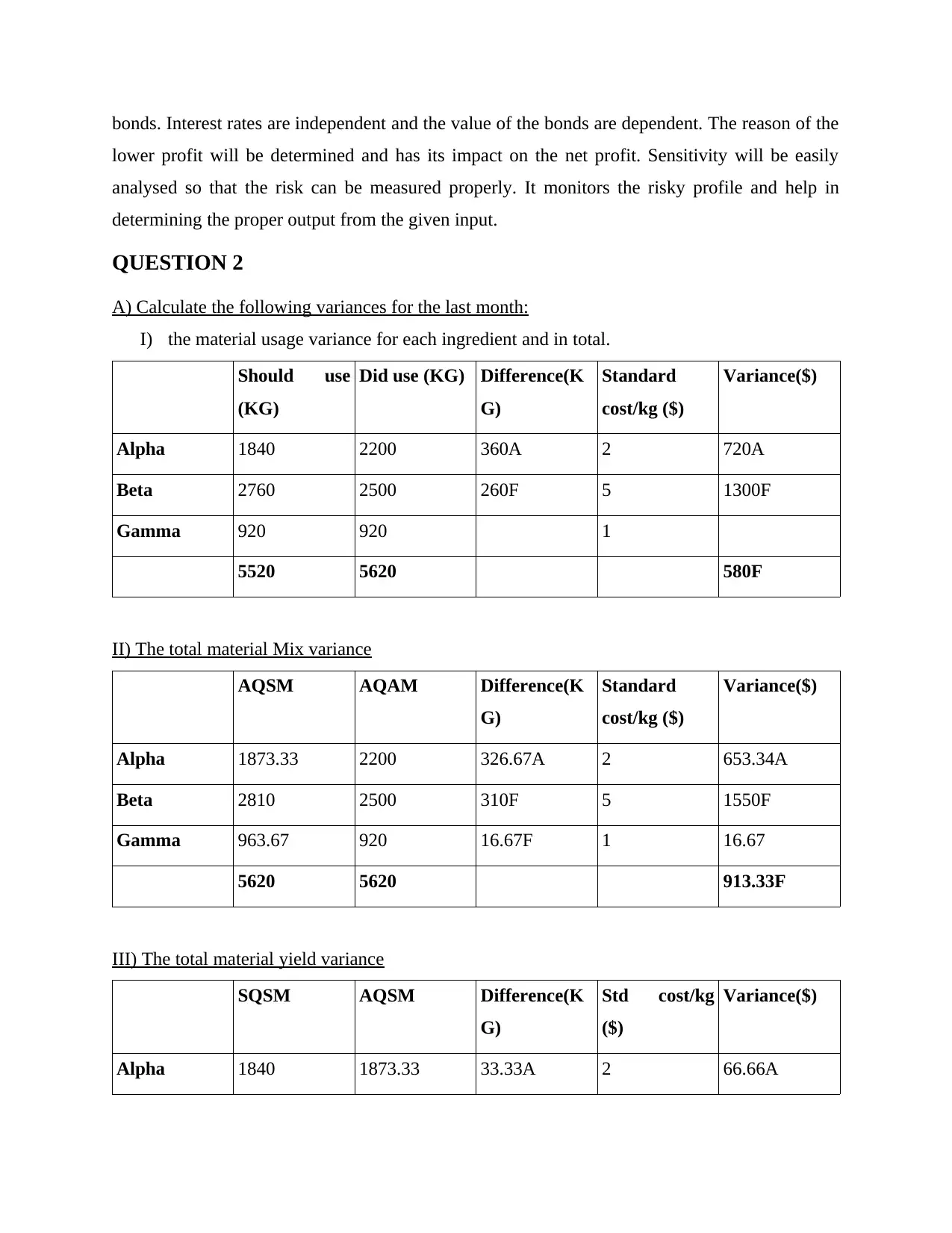
bonds. Interest rates are independent and the value of the bonds are dependent. The reason of the
lower profit will be determined and has its impact on the net profit. Sensitivity will be easily
analysed so that the risk can be measured properly. It monitors the risky profile and help in
determining the proper output from the given input.
QUESTION 2
A) Calculate the following variances for the last month:
I) the material usage variance for each ingredient and in total.
Should use
(KG)
Did use (KG) Difference(K
G)
Standard
cost/kg ($)
Variance($)
Alpha 1840 2200 360A 2 720A
Beta 2760 2500 260F 5 1300F
Gamma 920 920 1
5520 5620 580F
II) The total material Mix variance
AQSM AQAM Difference(K
G)
Standard
cost/kg ($)
Variance($)
Alpha 1873.33 2200 326.67A 2 653.34A
Beta 2810 2500 310F 5 1550F
Gamma 963.67 920 16.67F 1 16.67
5620 5620 913.33F
III) The total material yield variance
SQSM AQSM Difference(K
G)
Std cost/kg
($)
Variance($)
Alpha 1840 1873.33 33.33A 2 66.66A
lower profit will be determined and has its impact on the net profit. Sensitivity will be easily
analysed so that the risk can be measured properly. It monitors the risky profile and help in
determining the proper output from the given input.
QUESTION 2
A) Calculate the following variances for the last month:
I) the material usage variance for each ingredient and in total.
Should use
(KG)
Did use (KG) Difference(K
G)
Standard
cost/kg ($)
Variance($)
Alpha 1840 2200 360A 2 720A
Beta 2760 2500 260F 5 1300F
Gamma 920 920 1
5520 5620 580F
II) The total material Mix variance
AQSM AQAM Difference(K
G)
Standard
cost/kg ($)
Variance($)
Alpha 1873.33 2200 326.67A 2 653.34A
Beta 2810 2500 310F 5 1550F
Gamma 963.67 920 16.67F 1 16.67
5620 5620 913.33F
III) The total material yield variance
SQSM AQSM Difference(K
G)
Std cost/kg
($)
Variance($)
Alpha 1840 1873.33 33.33A 2 66.66A
Paraphrase This Document
Need a fresh take? Get an instant paraphrase of this document with our AI Paraphraser
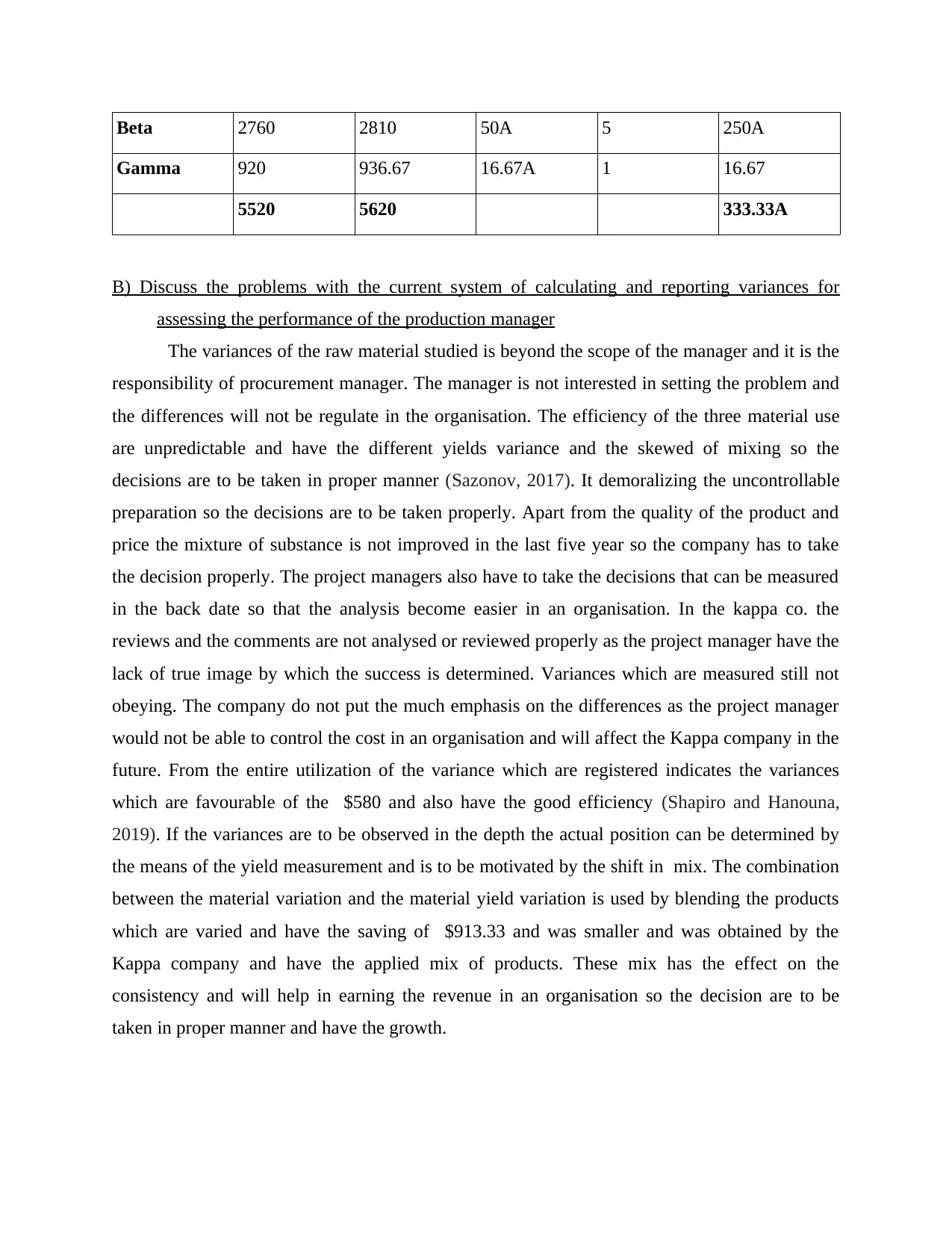
Beta 2760 2810 50A 5 250A
Gamma 920 936.67 16.67A 1 16.67
5520 5620 333.33A
B) Discuss the problems with the current system of calculating and reporting variances for
assessing the performance of the production manager
The variances of the raw material studied is beyond the scope of the manager and it is the
responsibility of procurement manager. The manager is not interested in setting the problem and
the differences will not be regulate in the organisation. The efficiency of the three material use
are unpredictable and have the different yields variance and the skewed of mixing so the
decisions are to be taken in proper manner (Sazonov, 2017). It demoralizing the uncontrollable
preparation so the decisions are to be taken properly. Apart from the quality of the product and
price the mixture of substance is not improved in the last five year so the company has to take
the decision properly. The project managers also have to take the decisions that can be measured
in the back date so that the analysis become easier in an organisation. In the kappa co. the
reviews and the comments are not analysed or reviewed properly as the project manager have the
lack of true image by which the success is determined. Variances which are measured still not
obeying. The company do not put the much emphasis on the differences as the project manager
would not be able to control the cost in an organisation and will affect the Kappa company in the
future. From the entire utilization of the variance which are registered indicates the variances
which are favourable of the $580 and also have the good efficiency (Shapiro and Hanouna,
2019). If the variances are to be observed in the depth the actual position can be determined by
the means of the yield measurement and is to be motivated by the shift in mix. The combination
between the material variation and the material yield variation is used by blending the products
which are varied and have the saving of $913.33 and was smaller and was obtained by the
Kappa company and have the applied mix of products. These mix has the effect on the
consistency and will help in earning the revenue in an organisation so the decision are to be
taken in proper manner and have the growth.
Gamma 920 936.67 16.67A 1 16.67
5520 5620 333.33A
B) Discuss the problems with the current system of calculating and reporting variances for
assessing the performance of the production manager
The variances of the raw material studied is beyond the scope of the manager and it is the
responsibility of procurement manager. The manager is not interested in setting the problem and
the differences will not be regulate in the organisation. The efficiency of the three material use
are unpredictable and have the different yields variance and the skewed of mixing so the
decisions are to be taken in proper manner (Sazonov, 2017). It demoralizing the uncontrollable
preparation so the decisions are to be taken properly. Apart from the quality of the product and
price the mixture of substance is not improved in the last five year so the company has to take
the decision properly. The project managers also have to take the decisions that can be measured
in the back date so that the analysis become easier in an organisation. In the kappa co. the
reviews and the comments are not analysed or reviewed properly as the project manager have the
lack of true image by which the success is determined. Variances which are measured still not
obeying. The company do not put the much emphasis on the differences as the project manager
would not be able to control the cost in an organisation and will affect the Kappa company in the
future. From the entire utilization of the variance which are registered indicates the variances
which are favourable of the $580 and also have the good efficiency (Shapiro and Hanouna,
2019). If the variances are to be observed in the depth the actual position can be determined by
the means of the yield measurement and is to be motivated by the shift in mix. The combination
between the material variation and the material yield variation is used by blending the products
which are varied and have the saving of $913.33 and was smaller and was obtained by the
Kappa company and have the applied mix of products. These mix has the effect on the
consistency and will help in earning the revenue in an organisation so the decision are to be
taken in proper manner and have the growth.

QUESTION 3
Critically discussed why neither ZBB nor the IB provides the perfect toll for planning
coordination and control.
Zero-based budgeting method is used to make a budget from the start or from the zero
stage so the decisions are to be taken in proper manner. These are not dependent on the budgets
which are prepared earlier in an organisation. The cost will be explained properly before apply
the Zero-based budgeting methods for the financial planning so the decision is to be taken in
proper manner. The main aim of the zero-based budgeting method is that the expenditure get
minimised and cutting down of the cost where it is possible. It helps in spending the budget
which needs the priority as the distribution are made according to that only. This budgeting
method is used by the various organisation to start the budget from the zero so that the actual
position can be analysed regarding the expenses and the revenue and the person can start saving
if the profit rises.
Role of Zero-based budgeting in planning and coordination:
The top level priorities of the strategic are to be incorporated in the phase of the
budgeting which is mostly encouraged by the Zero based budgeting. These are connected to the
firms functional regions when the expenditure are grouped and helps ion analysing the past
performance of the company in an proper manner. IT helps in motivating the employees and
engage them in decision making so that the results can be analysed in an organisation. During the
planning the possible adjustment are also taken into account so that the decisions are to be taken
properly. If the mistake will not analysed of the past budget than it will have the impact on the
future budgets also and will affect the organisation so the efficiency is to be measured on the
regular basis. These types of errors are easily solved in the ZBB method.
Incremental budgeting is a budget which focused on the minor adjustments of the budget
that is existing and the deal can be created in proper manner. The actual budget is used for the
budgetary control so that the adjustments that occurred can be applied or get deducted so that the
new budgets can be performed from the base amounts (Siminica, Motoi and Dumitru, 2017).
This type of budgeting is the restrictive strategy of the financial planning. The best is the gradual
budgeting which helps in analysing the plan properly for the present period so the future plan can
be estimated properly in an organisation. It is flexible and helps in saving the time in the
Critically discussed why neither ZBB nor the IB provides the perfect toll for planning
coordination and control.
Zero-based budgeting method is used to make a budget from the start or from the zero
stage so the decisions are to be taken in proper manner. These are not dependent on the budgets
which are prepared earlier in an organisation. The cost will be explained properly before apply
the Zero-based budgeting methods for the financial planning so the decision is to be taken in
proper manner. The main aim of the zero-based budgeting method is that the expenditure get
minimised and cutting down of the cost where it is possible. It helps in spending the budget
which needs the priority as the distribution are made according to that only. This budgeting
method is used by the various organisation to start the budget from the zero so that the actual
position can be analysed regarding the expenses and the revenue and the person can start saving
if the profit rises.
Role of Zero-based budgeting in planning and coordination:
The top level priorities of the strategic are to be incorporated in the phase of the
budgeting which is mostly encouraged by the Zero based budgeting. These are connected to the
firms functional regions when the expenditure are grouped and helps ion analysing the past
performance of the company in an proper manner. IT helps in motivating the employees and
engage them in decision making so that the results can be analysed in an organisation. During the
planning the possible adjustment are also taken into account so that the decisions are to be taken
properly. If the mistake will not analysed of the past budget than it will have the impact on the
future budgets also and will affect the organisation so the efficiency is to be measured on the
regular basis. These types of errors are easily solved in the ZBB method.
Incremental budgeting is a budget which focused on the minor adjustments of the budget
that is existing and the deal can be created in proper manner. The actual budget is used for the
budgetary control so that the adjustments that occurred can be applied or get deducted so that the
new budgets can be performed from the base amounts (Siminica, Motoi and Dumitru, 2017).
This type of budgeting is the restrictive strategy of the financial planning. The best is the gradual
budgeting which helps in analysing the plan properly for the present period so the future plan can
be estimated properly in an organisation. It is flexible and helps in saving the time in the
⊘ This is a preview!⊘
Do you want full access?
Subscribe today to unlock all pages.

Trusted by 1+ million students worldwide
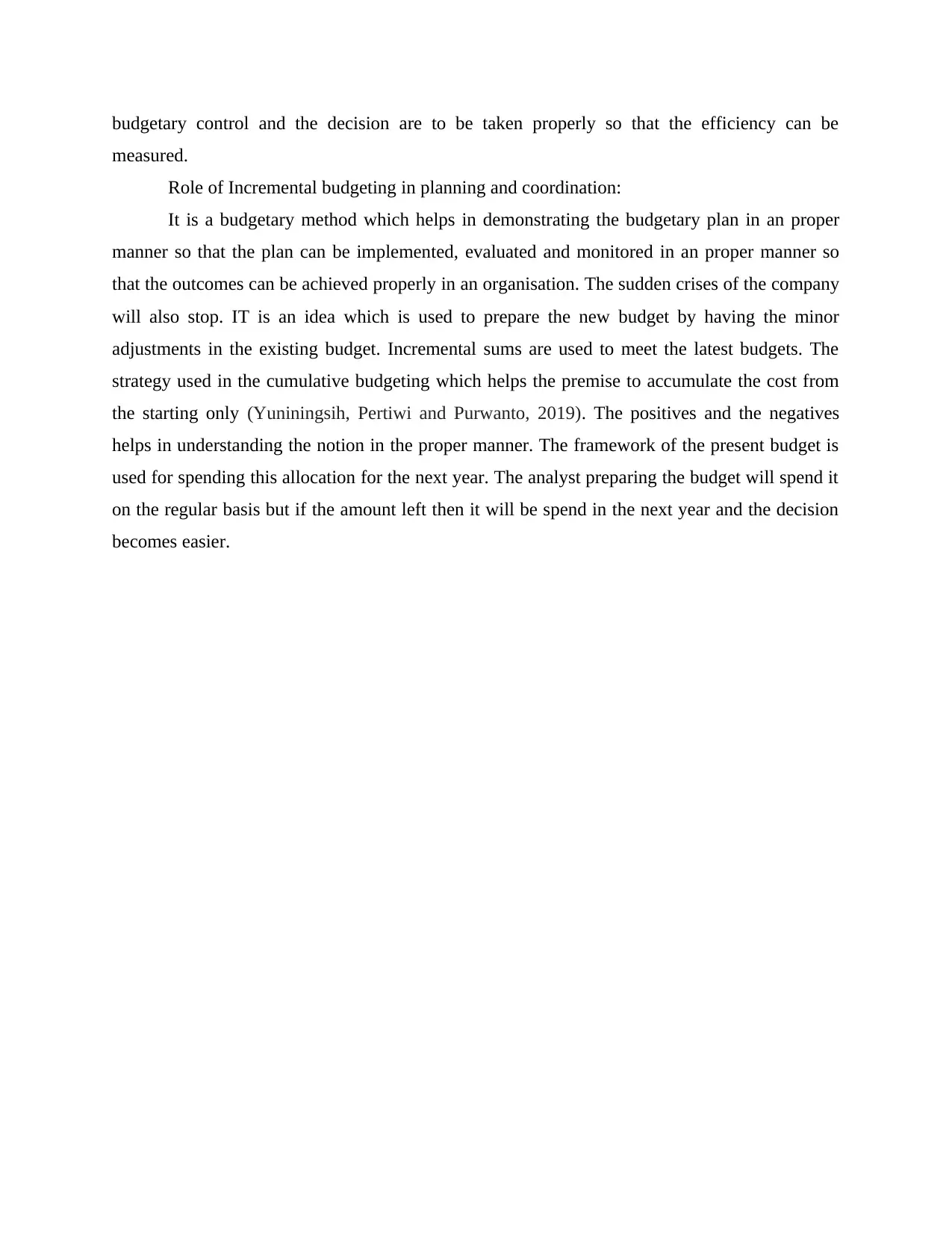
budgetary control and the decision are to be taken properly so that the efficiency can be
measured.
Role of Incremental budgeting in planning and coordination:
It is a budgetary method which helps in demonstrating the budgetary plan in an proper
manner so that the plan can be implemented, evaluated and monitored in an proper manner so
that the outcomes can be achieved properly in an organisation. The sudden crises of the company
will also stop. IT is an idea which is used to prepare the new budget by having the minor
adjustments in the existing budget. Incremental sums are used to meet the latest budgets. The
strategy used in the cumulative budgeting which helps the premise to accumulate the cost from
the starting only (Yuniningsih, Pertiwi and Purwanto, 2019). The positives and the negatives
helps in understanding the notion in the proper manner. The framework of the present budget is
used for spending this allocation for the next year. The analyst preparing the budget will spend it
on the regular basis but if the amount left then it will be spend in the next year and the decision
becomes easier.
measured.
Role of Incremental budgeting in planning and coordination:
It is a budgetary method which helps in demonstrating the budgetary plan in an proper
manner so that the plan can be implemented, evaluated and monitored in an proper manner so
that the outcomes can be achieved properly in an organisation. The sudden crises of the company
will also stop. IT is an idea which is used to prepare the new budget by having the minor
adjustments in the existing budget. Incremental sums are used to meet the latest budgets. The
strategy used in the cumulative budgeting which helps the premise to accumulate the cost from
the starting only (Yuniningsih, Pertiwi and Purwanto, 2019). The positives and the negatives
helps in understanding the notion in the proper manner. The framework of the present budget is
used for spending this allocation for the next year. The analyst preparing the budget will spend it
on the regular basis but if the amount left then it will be spend in the next year and the decision
becomes easier.
Paraphrase This Document
Need a fresh take? Get an instant paraphrase of this document with our AI Paraphraser
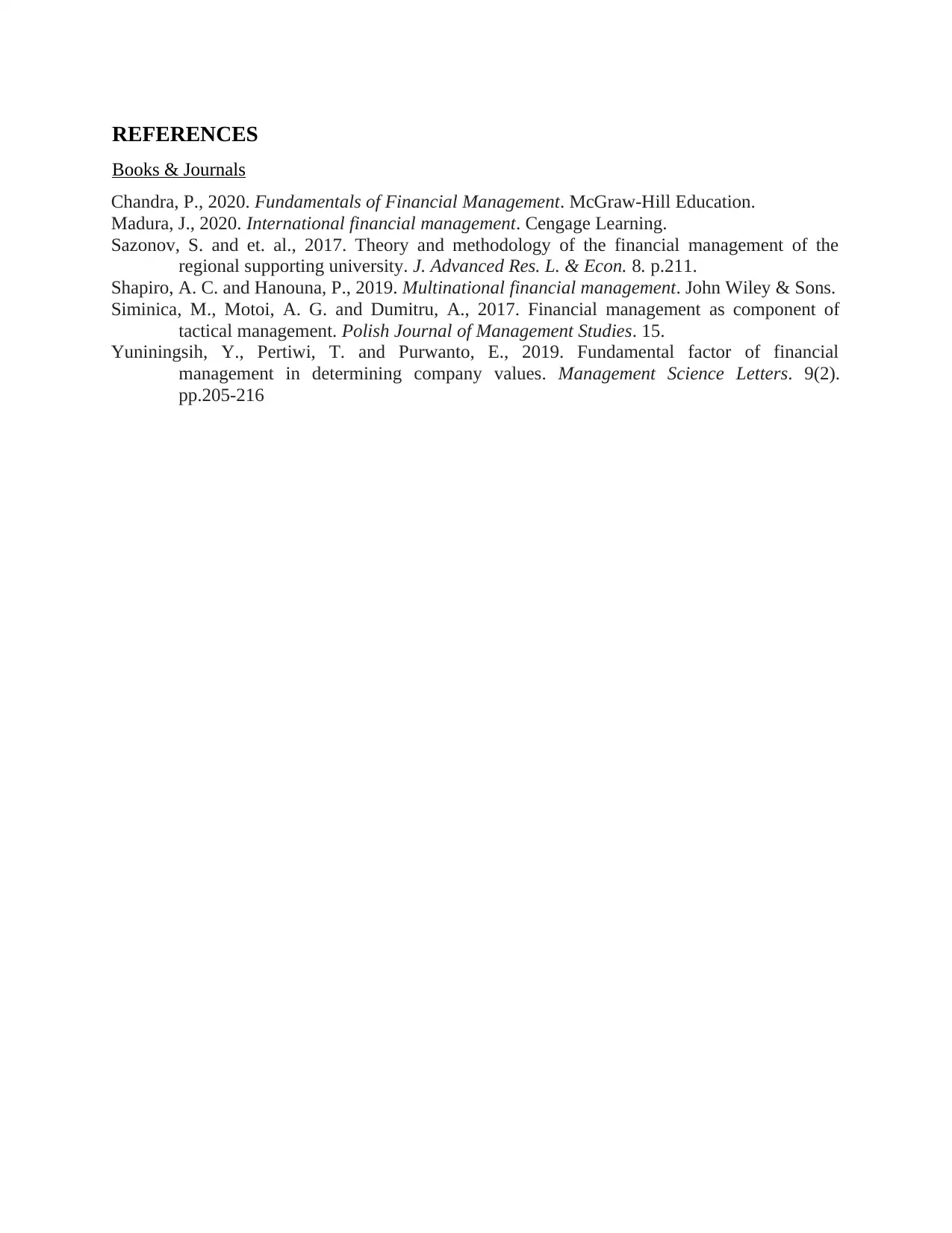
REFERENCES
Books & Journals
Chandra, P., 2020. Fundamentals of Financial Management. McGraw-Hill Education.
Madura, J., 2020. International financial management. Cengage Learning.
Sazonov, S. and et. al., 2017. Theory and methodology of the financial management of the
regional supporting university. J. Advanced Res. L. & Econ. 8. p.211.
Shapiro, A. C. and Hanouna, P., 2019. Multinational financial management. John Wiley & Sons.
Siminica, M., Motoi, A. G. and Dumitru, A., 2017. Financial management as component of
tactical management. Polish Journal of Management Studies. 15.
Yuniningsih, Y., Pertiwi, T. and Purwanto, E., 2019. Fundamental factor of financial
management in determining company values. Management Science Letters. 9(2).
pp.205-216
Books & Journals
Chandra, P., 2020. Fundamentals of Financial Management. McGraw-Hill Education.
Madura, J., 2020. International financial management. Cengage Learning.
Sazonov, S. and et. al., 2017. Theory and methodology of the financial management of the
regional supporting university. J. Advanced Res. L. & Econ. 8. p.211.
Shapiro, A. C. and Hanouna, P., 2019. Multinational financial management. John Wiley & Sons.
Siminica, M., Motoi, A. G. and Dumitru, A., 2017. Financial management as component of
tactical management. Polish Journal of Management Studies. 15.
Yuniningsih, Y., Pertiwi, T. and Purwanto, E., 2019. Fundamental factor of financial
management in determining company values. Management Science Letters. 9(2).
pp.205-216
1 out of 11